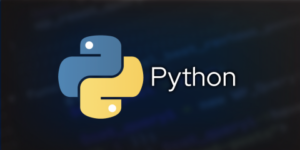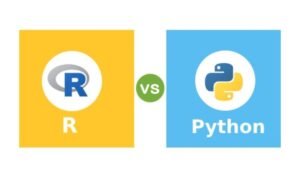Data science is known as a process for taking knowledge and details from a big and diverse set of data by organizing, processing, and analyzing the data. It involves many various kinds of different mathematical and statistical modeling, extracting data from its source, and applying data visualization techniques. It involves handling big data technologies to gather both structured and unstructured data.
Consider the example recommendation system online shopping becomes, prevalent the e-commerce platforms which capture the users shopping as well as the performance of various products in the market. This leads to the creation of a recommendation system that creates models predicting the shopper’s needs and show the products the shopper is most often to buy.
Python Data Science
This programming necessities of data science wants versatile flexible language which is simple to write the code but can handle highly complex mathematical processing. Python is suited for requirements which are already established itself both as the language for general computing as well as scientific computing. The features of python make it the preferred language for data science.
- It is simple and very easy to learn language where the achievers result in lesser lines of codes than the other similar languages like R. The simplicity also makes it robust to handle complex scenarios with the minimal code and much less confusion on the general flow of the program.
- Its cross-platform is same as code works in multiple environments without needing any change it will make the perfect environment used to multi-environment setup only.
- It executes quicker and very faster than other similar languages that s used for data analysis like R and MATLAB.
- This has memory management capacity specifically garbage collection does it versatile in gracefully managing very large volume data transformation, slicing, dicing and visualization.
- Python has huge collection of libraries which serve the special purpose analysis tools. For example the Numpy package deals with scientific computing and its array needs much less memory than the conventional python list managing numeric data.
To recent updated and current source code, binaries, documentation, the news is available on the official website of python http://www.python.org
Installing python:
Python language distribution is required for a variety of interfaces that require downloading only binary code that is applicable for your platform and maybe installing python. This is purely binary code for the platform will not be available we need a C compiler to compile the source code manually compiling the source code offers more flexibility in terms of choosing the features that we require in your installation.
Here Unix and Linux installation
We have simple steps for installation of python UNIX/Linux machine
- Here we have to open a web browser and click the link https://www.python.org/downloads
- We have to follow the link to download zipped source code available unix/linux download and extract files.
- editing the modules/setup file if we want to customize some options.
- run./configure script
- make install
Windows installation:
The steps to install python on a Windows machine
- We have to open web browser and to the https://www.python.org/downloads/
- here we should click the link for windows installer python-XYZ.msi file as XYZ is the version that we wants to install.
- Execute the downloaded file. This will perform the python installation wizard that is really easy to use.
Setting the path:
The actual directory will be saved in the environment variable it has given name as string managed by the operating system. This variable contains information that is available to the command shell and also other programs. The Path variable will be named as PATH in Unix or Path in windows.
Setting the path in windows
- we have to include python directory to the path for particular session in windows
- At the command prompt-type path %path% ;C:\Python and also press enter.
- consider C:\Python is the path of the python directory.
Questions
- What is the use of Python in Data Science?
- Explain the installation steps of Python in Linux?






























13 Responses
Data science is the process of getting knowledge and details from the huge amount of data by processing, modelling and visualizing it. It involves mathematical and structural modelling.It is done by extracting data from various sources and applying visualization techniques. The necessity of data science want simple coding language which can handle complex mathematical computation.
]ython is very suitable language for data science.
This programming necessities of data science wants versatile flexible language which is simple to write the code but can handle highly complex mathematical processing. Python is suited for requirements which are already established itself both as the language for general computing as well as scientific computing. The features of python make it the preferred language for data science.
It is simple and very easy to learn language where the achievers result in lesser lines of codes than the other similar languages like R. The simplicity also makes it robust to handle complex scenarios with the minimal code and much less confusion on the general flow of the program.
Its cross-platform is same as code works in multiple environments without needing any change it will make the perfect environment used to multi-environment setup only.
It executes quicker and very faster than other similar languages that s used for data analysis like R and MATLAB.
This has memory management capacity specifically garbage collection does it versatile in gracefully managing very large volume data transformation, slicing, dicing and visualization.
Python has huge collection of libraries which serve the special purpose analysis tools. For example the Numpy package deals with scientific computing and its array needs much less memory than the conventional python list managing numeric data.
The steps to install python on a Windows machine
We have to open web browser and to the https://www.python.org/downloads/
here we should click the link for windows installer python-XYZ.msi file as XYZ is the version that we wants to install.
Execute the downloaded file. This will perform the python installation wizard that is really easy to use.
1) What is the use of Python in Data Science?
* Python is open source, high level language used by data scientist for various data science projects/application.
* Python provide great functionality to deal with mathematics, statistics and scientific function.
* It is simple and very easy to learn language and much less confusion on the general flow of the program.
* By using Python the people can communicate with other. The other reason is rooted in academic research and statistical models.
* It executes quicker and very faster than other similar languages that s used for data analysis like R and MATLAB.
* It has memory management capacity for managing very large volume data transformation, slicing, dicing and visualization.
* Numpy package deals with scientific computing and its array needs much less memory than the conventional python list managing numeric data.
2) Explain the installation steps of Python in Linux?
Steps for installation of python UNIX/Linux machine:
* open a web browser
* click the link https://www.python.org/downloads
* follow the link to download zipped source code available unix/linux download and extract files.
* To customize some options -editing the modules/setup file
* run./configure script
* make install
Windows installation:
The steps to install python on a Windows machine:
* Open web browser and to the https://www.python.org/downloads/
* Click the link for windows installer python-XYZ.msi file as XYZ is the version that we wants to install.
* Execute the downloaded file.
* perform the python installation wizard that is really easy to use.
A.Python in data science.
This programming necessities of data science wants versatile flexible language which is simple to write the code but can handle highly complex mathematical processing. Python is suited for requirements which are already established itself both as the language for general computing as well as scientific computing. The features of python make it the preferred language for data science.
It is simple and very easy to learn language where the achievers result in lesser lines of codes than the other similar languages like R. The simplicity also makes it robust to handle complex scenarios with the minimal code and much less confusion on the general flow of the program.
Its cross-platform is same as code works in multiple environments without needing any change it will make the perfect environment used to multi-environment setup only.
It executes quicker and very faster than other similar languages that s used for data analysis like R and MATLAB.
This has memory management capacity specifically garbage collection does it versatile in gracefully managing very large volume data transformation, slicing, dicing and visualization.
Python has huge collection of libraries which serve the special purpose analysis tools. For example the Numpy package deals with scientific computing and its array needs much less memory than the conventional python list managing numeric data.
B.Installation steps of python in LINUX.
a. Here we have to open a web browser and click the link https://www.python.org/downloads
b. We have to follow the link to download zipped source code available linux download and extract files.
c. editing the modules/setup file if we want to customize some options.
d. run./configure script
e. make install
1.What is the use of Python in Data Science?
-Python is flexible language which is simple to write the code but can handle highly complex mathematical
processing.
– It is simple and very easy to learn language where the achievers result in lesser lines of codes than the other similar
languages like R. The simplicity also makes it robust to handle complex scenarios with the minimal code and much
less confusion on the general flow of the program.
-Its cross-platform is same as code works in multiple environments without needing any change it will make the
perfect environment used to multi-environment setup only.
-It executes quicker and very faster than other similar languages that is used for data analysis like R and MATLAB.
-This has memory management capacity specifically garbage collection does it versatile in gracefully managing very
large volume data transformation, slicing, dicing and visualization.
-Python has huge collection of libraries which serve the special purpose analysis tools.
2.Explain the installation steps of Python in Linux?
1. Here we have to open a web browser and click the link https://www.python.org/downloads
2. We have to follow the link to download zipped source code available Unix/Linux download and extract files.
3. editing the modules/setup file if we want to customize some options.
4. run. /Configure script
5. make install
This programming necessities of data science wants versatile flexible language which is simple to write the code but can handle highly complex mathematical processing. Python is suited for requirements which are already established itself both as the language for general computing as well as scientific computing. The features of python make it the preferred language for data science.
It is simple and very easy to learn language where the achievers result in lesser lines of codes than the other similar languages like R. The simplicity also makes it robust to handle complex scenarios with the minimal code and much less confusion on the general flow of the program.
Its cross-platform is same as code works in multiple environments without needing any change it will make the perfect environment used to multi-environment setup only.
It executes quicker and very faster than other similar languages that s used for data analysis like R and MATLAB.
This has memory management capacity specifically garbage collection does it versatile in gracefully managing very large volume data transformation, slicing, dicing and visualization.
Python has huge collection of libraries which serve the special purpose analysis tools. For example the Numpy package deals with scientific computing and its array needs much less memory than the conventional python list managing numeric data.
We have simple steps for installation of python UNIX/Linux machine
Here we have to open a web browser and click the link https://www.python.org/downloads
We have to follow the link to download zipped source code available unix/linux download and extract files.
editing the modules/setup file if we want to customize some options.
run./configure script
make install
Introduction to Data Science with Python:
What is the use of Python in Data Science?
To organize, process and analyze data from a big and diverse set of dataset from multiple sources, we need a well established language called ‘Python’. It’s simple to write the code, yet can handle complex mathematical processing. Python has versatile features that suit general computing as well as scientific computing. So, it perfectly fulfills the requirements of the data science field.
-Code: simple, easy to learn, minimal code, less confusion but achieve results.
-Multi-environment setup
-Quicker and faster execution
-Memory management capacity
-Huge collection of python libraries serve a plenty of special purpose analysis tools.
Explain the installation steps of Python in Linux?
Python installation in Linux:
*Open the web browser ‘https://www.python.org/downloads’
*Download zipped source code available unix/linux download
*Extract files
*Edit the modules or setup file to customize the options
*run./configure script
*Install
1.What is the use of Python in Data Science?
-Python is easy to learn.
-There are many open-source Python libraries for mathematics, statistics, data visualization, and data modeling.
-Leading tech companies are using Python for their advanced applications, including face recognition, object detection, natural language processing, and content generation.
-Python programming language is efficient, scalable, and production-ready.
-Python has a strong and supportive community.
2. Explain the installation steps of Python in Linux?
open a web browser and click the link https://www.python.org/downloads.
follow the link to download zipped source code available unix/linux download and extract files.
Execute the downloaded file. This will perform the python installation wizard .
This programming necessities of data science wants versatile flexible language which is simple to write the code.
It can handle highly complex mathematical processing. Python is suited for requirements which are already established itself both as the language for general computing as well as scientific computing. The features of python make it the preferred language for data science.
It is simple and very easy to learn the language where the achievers result in lesser lines of codes than the other similar languages like R. The simplicity also makes it robust to handle complex scenarios with the minimal code and much less confusion on the general flow of the program.
Its cross-platform is same as code works in multiple environments without needing any change it will make the perfect environment used to multi-environment setup only.
It executes quicker and very faster than other similar languages that s used for data analysis like R and MATLAB.
This has memory management capacity specifically garbage collection does it versatile in gracefully managing very large volume data transformation, slicing, dicing and visualization.
Python has huge collection of libraries which serve the special purpose analysis tools. For example the Numpy package deals with scientific computing and its array needs much less memory than the conventional python list managing numeric data.
–steps for installation of python UNIX/Linux machine
open a web browser and click the link https://www.python.org/downloads
We have to follow the link to download zipped source code available unix/linux download and extract files.
editing the modules/setup file if we want to customize some options.
run./configure script
make install
Questions
1. What is the use of Python in Data Science?
Python is a language that’s simple and easier to use, which makes it robust to handle complex scenarios with the minimal code. This is necessary for Data Science which requires versatile flexible language which is simple to write the code but can handle highly complex mathematical processing. Since its code works in multiple environments, it’s cross-platform is the same. It executes quicker and very faster than other similar languages used for data analysis, has memory management capacity specifically garbage collection, and has huge collection of libraries which serve the special purpose analysis tools.
2. Explain the installation steps of Python in Linux?
• Here we have to open a web browser and click the link https://www.python.org/downloads
• We have to follow the link to download zipped source code available unix/linux download and extract files.
• editing the modules/setup file if we want to customize some options.
• run./configure script
• make install
In order to set the path, the actual directory will be saved in the environment variable it has given name as string managed by the operating system. This variable contains information that is available to the command shell and also other programs. The Path variable will be named as PATH in Unix or Path in windows.
What is the use of Python in Data Science?
a. It uses elegant syntax, hence the programming is easier to read.
b. It is an easy-to-access language.
c. The large standard library and community support for mathematics and Data science purposes.
d. Python’s interactive mode makes it easy to evaluate codes.
e. By adding new modules that are implemented in other compiled languages like C++ or C, it’s quite easy to expand the code in Python.
f. Python is a powerful language that can be integrated into programs to provide a customizable interface.
g. It allows developers to run the code on Windows, Mac OS X, UNIX, and Linux.
h. It is open-source interpreted, high-level language. Use, download, and program addition of Pythons are all free of charge.
2. Explain the installation steps of Python in Linux?
Step 1 – Install Development Packages Required to Install Python on Linux- …
Step 2 – Download the Latest Version of Python.
Step 3 – Extract the tar file to install Python on Linux.
Step 4 – Configure the Script.
1. There are many reasons that python is used for data science. This language is simple and easy to learn because it uses less lines of codes than other languages like R and it is robust to handle complex scenarios with minimal code and less confusion on the general flow of the program. Python has many libraries such as NumPy which has scientific computing and its array needs less memory than conventional python list managing numeric data. Python executes quicker than other languages and has memory management capacity for managing large data transformation, slicing, dicing and visualization.
2. The steps to install python on Linux/Unix machine are:
Open a web browser and click on the link https://www.python.org/downloads.
Follow the link to download zipped source code available Unix/Linux download and extract files.
Edit the modules/setup file to customize some options.
Run./configure script
Make install
1) What is the use of Python in Data Science?
A) Some of the main uses of Python in data science include:
-Data Cleaning and Manipulation: Python provides powerful tools for data manipulation and cleaning, such as Pandas, Numpy, and Scipy libraries, which allow you to work with data in various formats, clean and preprocess data, and perform data transformations.
-Data Visualization: Python has several libraries for data visualization, such as Matplotlib, Seaborn, Plotly, and Bokeh, which allow you to create insightful visualizations and plots to communicate your findings effectively.
-Machine Learning: Python provides a variety of machine learning libraries, such as Scikit-learn, TensorFlow, Keras, PyTorch, and XGBoost, which allow you to build predictive models, perform feature selection and engineering, and evaluate model performance.
-Deep Learning: Python is widely used in deep learning applications due to its flexible syntax and its deep learning libraries, such as TensorFlow, Keras, and PyTorch, which make it easy to build complex neural network architectures and train models on large datasets.
2. Explain the installation steps of Python in Linux?
Step 1 – Install Development Packages Required to Install Python on Linux- …
Step 2 – Download the Latest Version of Python.
Step 3 – Extract the tar file to install Python on Linux.
Step 4 – Configure the Script.